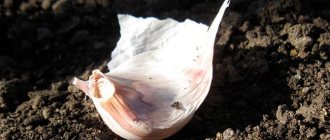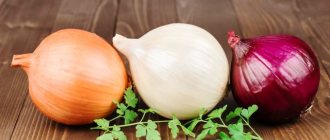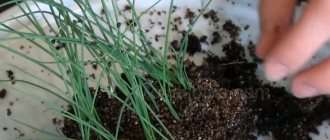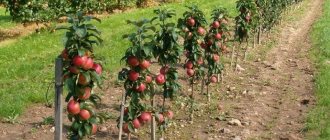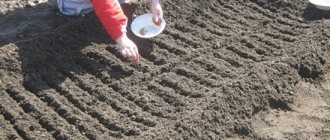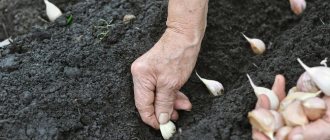1 / 5 ( 2 voices)
Good day everyone!
On the agenda today I have an important issue for gardeners and amateur gardeners. Tell me, have you already prepared the garlic for winter, I mean planted it in the ground in the fall, so that you can harvest it in the summer?
Let's figure out when and how to do this work correctly. What you need to know and be able to do so that later your favorite aromatic and spicy vegetable will please us with a large harvest, because almost any main course or, for example, a real tasty rich Ukrainian borscht with garlic donuts, will not do without it.
It is used very often in folk medicine and is also a repellent for many soil inhabitants.
But I think I won’t write about the benefits of this vegetable crop in this note, because it seems to me that its benefits are obvious to all of us, and we know how? and where it can be used. Well, for those who are already unbearably interested, you can always find any information on the Internet.
Unfavorable days in spring 2021
· March: 3, 17, 18, 30, 31;
April: 15, 16, 29, 30;
May: 14, 15, 16, 28.
Garlic planted in spring is called spring garlic. It is very durable, and if garlic planted in the fall is not stored for longer than a year, then spring garlic can be stored for up to 2 years. However, the yield of spring garlic is much smaller.
We recommend reading these articles:
Treating the garden with urea in the spring against pests and diseases
Favorable days for planting peppers in March 2021
Favorable days for planting eggplants in March 2021
Favorable days for planting
The best planting days for garlic are in mid-autumn, approximately 30-45 days before the onset of sustained frost. Often the procedure is carried out in late September or throughout October. If you plant a plant too late, there is a high probability that it will die before it has time to take root. In the case of early planting, sprouts appear in the fall, which will not survive the winter.
According to the phases of the moon
Most gardeners become familiar with the lunar calendar before planting. In it, astrologers display the phases of the moon, which influence the development of cultures. So, if it is growing, then the above-ground part develops more actively, because at this time the juices move upward.
During the decreasing phase, the movement of liquids occurs in the opposite direction and the root system is actively formed. Therefore, it is better if garlic is planted during this period. On the days of the New Moon and Full Moon, it is better to postpone planting work.
Favorable days for planting garlic in 2021 are shown in the table
| Month | Allowed days | Prohibited days |
| September | 1, 2,3, 24, 25, 29 and 30 | 5, 6, 22 |
| October | 23, 25, 26 and 27 | 1-2, 14 |
| November | 2, 3, 21, 23, 24, 28 and 30 | 5, 10, 11, 15, 16 and 25 |
Attention! You can plant crops on other days, the main thing is to avoid unfavorable ones.
To reap a good harvest, the slices must be planted on the dates when the Moon passes through the fertile Zodiac Signs, which include Cancer, Scorpio, Pisces and Taurus.
Based on region
Winter varieties are planted in the fall so that the cloves have time to take root before the onset of persistent cold weather, but do not begin to germinate. The development of the root system takes 1-1.5 months. For this reason, planting dates differ depending on the region with its own climate.
For example, in the Moscow region and in other regions of the central zone, sub-zero temperatures become stable in the second ten days of November. Therefore, garlic is planted here in early October, around the 11th-14th.
In the southern part of Central Russia, landing is possible later, in the last days of the month. And in the Leningrad region the climate is a little colder, so planting in this region must be completed by the end of September.
It gets colder in Siberia earlier. Therefore, winter varieties are planted here in the second half of September. Depending on the weather, the date may be moved earlier or later. It is important to complete planting before the soil has cooled to +10°C. In the Urals, winter varieties of vegetables are planted after October 15. For the northern part of the region, numbers from 16 to 23 are suitable, and for the southern part - from 25 to 30.
Choosing a garlic variety for planting
You can distinguish winter varieties from spring varieties by their external characteristics. In varieties for winter planting, the cloves are arranged in a single row around the stem. They are all large, the same size and shape. During the growing season they form an arrow. Bulbs then ripen on it, which are used for reproduction. Spring varieties have smaller segments. There is no central shaft, and the teeth are arranged in a spiral. Such plants do not form arrows.
To obtain a rich harvest, only high-quality planting material is taken. Suitable for planting are bulbs with roots on a dense bottom that do not crumble when pressed. They should have tightly closed segments, and the surface should be covered with dry husk.
Benefits of autumn planting
Many experienced vegetable growers recommend planting garlic in the fall. There are several reasons for this:
- The heads grow larger and denser than when planted in the spring.
- The growing season of the vegetable is reduced. After the onset of warmth, winter garlic immediately begins to grow, while spring garlic is only planted in the ground at this time. Thanks to autumn planting, the harvest is dug up 20-40 days earlier.
- In the spring, the time saved on planting can be spent on other garden work.
Although planting garlic in fall and spring is largely the same, there are significant differences. When planting before winter, planting material is placed deeper and in several tiers. Winter varieties are planted more densely, but this does not affect the size of the harvest. They do not suffer from low temperatures if the spring turns out to be cold. The plants still take root and grow quickly.
The best varieties of winter garlic:
- The Komsomolets variety has an average growing season of 110 to 120 days. A head weighing up to 50 g contains 6-10 lobules. Garlic has a pungent taste and a pungent aroma. The plant tolerates drought and low temperatures well.
- The Alcor variety has a short growing season of 85 to 95 days. It is characterized by high productivity, producing medium-sized heads weighing up to 35 g, containing from 4 to 6 cloves. They have a pungent taste and no pungent odor.
- Garlic "Sofia" was bred by Ukrainian breeders. Its ripening period is 110 days. The variety tolerates frost well and grows successfully in moist soil. Each head weighing up to 120 g contains from 8 to 10 cloves with a pungent taste.
- The early ripening variety “Lyubasha” produces up to 3.5 kg of bulbs per 1 m². The weight of each of them reaches 200 g. One head contains from 4 to 7 cloves with a pungent taste. The variety has good keeping quality.
- The Dobrynya variety has a growing season of 130 days and is characterized by good winter hardiness and resistance to major infections. The heads weighing up to 55 g consist of 10-12 segments with a mildly pungent taste.
- The yield of the early ripening variety “Zubrenok” is up to 1.1 kg per 1 m² of planting. The duration of the growing season reaches 100 days. Each head weighing 70 g contains from 5 to 7 cloves with white-pink flesh and a pungent taste.
- The frost-resistant variety “Parus” is characterized by high yield. It produces up to 1.5 kg of fruit from 1 m² of bed. Each onion weighs up to 40 g and consists of 6-8 cloves, which have a pungent taste and pungent odor.
- The early ripening variety “Lekar” ripens within 110 days, has excellent frost resistance, and produces a high yield. Each head weighs up to 65 g, consists of 11-18 cloves with pale pink flesh and a slightly pungent taste.
- The early ripening variety “Bashkirsky 85” ripens within 90 days after germination. The heads weigh up to 65 g. Each contains 4-5 dense cloves with a pungent taste. The variety has strong immunity to peronospora and fusarium.
Preparation of soil and planting material
Before planting begins, equipment is prepared. If shallow planting is chosen, a rake and a hoe are needed for the job. When placing the slices at a depth of 7 to 9 cm, you will need a hand plow. If the depth of the planting material is more than 10 cm, use a peg and a hammer. To ensure that the planting depth is the same, a mark is made on the peg.
The location for the garden bed is chosen taking into account crop rotation. Good predecessors for vegetables are cruciferous, melon, nightshade crops or greens. They saturate the soil with the beneficial elements necessary for garlic. Areas where any root crops previously grew are not suitable. They deplete the soil and leave behind pests to which the vegetable is susceptible.
After what crop can garlic be planted?
Proper rotation of fruit crops annually reduces the risk of crop diseases, helps control weeds and improves the soil.
Garlic is good to plant after tomatoes, cucumbers and beets, as well as legumes. The beds left over from any types of cabbage, pumpkin and zucchini are suitable.
It is strictly not recommended to plant garlic after bulbous crops. Such an action can lead to the loss of the entire crop. The fact is that onions and garlic suffer from the same diseases, due to which a newly planted species can deteriorate even before spring and lose its ability to grow. The same applies to the soil on which potatoes previously grew.
Today, many gardeners prefer to plant all the fertile soil with oats or mustard, as well as other green manures after harvesting to enrich the land with useful components.
Garlic does not really like to grow in the soil where similar crops grew. Therefore, it is better to refrain from sowing green manure in a bed intended for garlic.
You can plant a crop in your garden bed for no more than two years in a row. To avoid crop diseases and crushing. In addition, garlic does not like acidic soil, which is formed mainly near coniferous trees, thanks to the humus obtained from needles and cones. The planting bed should be selected away from areas where coniferous trees grow, in order to avoid crop loss.
Care after landing
In the spring, as soon as it gets warm, cover material or mulch is removed from the beds so that the seedlings can quickly make their way to the top. Water the garlic for the first time as soon as the soil dries out and while it is growing green mass, do not spare water. When the heads begin to ripen, watering is reduced, and if the weather is rainy, they are stopped completely. After each watering, the soil is loosened, weeding at the same time. This must be done carefully so as not to harm the developing heads and roots. To reduce the number of waterings and weedings, you can mulch the grown garlic with hay, straw, and sawdust from deciduous trees.
You need to feed the plants first with fertilizers containing N, and then P and K. You can use both ready-made mineral mixtures and organic matter, to which garlic responds very well. For mineral fertilizers, use saltpeter (20 g per bucket of water); for organic fertilizers, use an infusion of fresh manure (1 to 10). Start fertilizing as soon as the green sprouts have reached a height of approximately 10 cm. After a month, carry out another fertilizing - this time water the plants with an ash solution (200 g of ash per bucket of water).
When the plants throw out arrows, break them off without waiting for them to become coarse. This allows you to get larger heads and speed up their maturation. Leave the arrows only if you need to get bulbs to refresh the variety.
Preparing heads for planting
At the beginning, the seed is left in a cool place with a temperature not exceeding +4 °C for several weeks. Then the heads are carefully disassembled into cloves so as not to damage the scales. Rotten and suspicious specimens are removed, since even one diseased tooth can infect the entire garden bed. Only large planting material with a flat surface is left.
Important!
A good option is local garlic, obtained from the region where planting is planned.
After selection, the garlic is disinfected. The teeth are kept in a 0.1% solution of potassium permanganate, placed in a solution of copper sulfate (proportion - 1 tablespoon of substance per 10 liters of water) for a couple of minutes or soaked in water with Fitosporin for 30 minutes. An alternative to the above methods is to sprinkle the prepared cloves with colloidal sulfur powder.
We recommend reading these articles:
Treatment of aloe seeds before sowing reviews
Disinfection of seeds before planting at home
How to speed up the germination of sweet pepper seeds
When to plant winter garlic in Russian regions
When to plant garlic - in September, October or November - depends on the climate of the area and the weather conditions of the season. There is a general rule: cloves are planted 2-3 weeks before the first frost.
October or November
There are no exact dates. Here are approximate periods:
- southern regions - end of October - last days of November;
- European part of Russia - late September - mid-October;
- Siberia, Ural, North-West - September - first ten days of October.
Most popular vegetable
In northern regions with sharp temperature changes, they are guided by short-term forecasts.
Important! In regions with a harsh climate, it is necessary to insulate the beds with film, roofing felt, and spruce branches.
If you rush and plant garlic early, it will germinate before frost and die. Being late is also dangerous - the teeth will not take root and will freeze.
Soil requirements and planting pattern
Garlic grows successfully in flat, well-lit, weed-free beds. They must be protected from sudden gusts of wind. The soil on them is dug up a month before sowing at a depth of about 20-25 cm. It is not recommended to do this immediately before planting, otherwise the cloves will go too deep underground, experience a lack of air and eventually die.
It is better to plant the crop in soil with a neutral acidity level (pH from 6 to 6.5). Loamy soil and sandy loam meet this criterion. At the same time, correct crop rotation is observed. Eggplants, cabbage, peppers, and tomatoes will be useful predecessors for garlic, but it is not advisable to plant it after onions or carrots. It is recommended to return the vegetable to its original place no earlier than after 5 years.
Before sowing begins, the beds are marked. On average, their width reaches from 1 to 1.5 m. A groove is placed on the bed every 20-25 cm. Its optimal depth is from 5 to 7 cm. Leave 10 cm between planted cloves.
How to plant garlic bulbs before winter so that it grows large?
But as for garlic with bulbs and not cloves, this type can be planted in April. This type of garlic is called spring, not winter.
Remember that if you plant bulbs, they will bear a real harvest only after a year. In the first year, only a clove will grow from one bulb, and already in the second year, a whole head will grow from this clove.
The bulbs still sound cool, such small and funny things))).
I suggest watching the video and learning how to plant garlic this way correctly:
Growing Garlic
To plant winter vegetables, you should choose a lighted area on a hill, which will help avoid flooding during rains or melting snow. Avoid places with waterlogged or swampy soil. Garlic grows best on sandy or loamy soil.
To obtain a rich harvest and prevent infection, the planting site must be selected taking into account crop rotation. The best predecessors are beans, beans, tomatoes, peppers, carrots, beets, and melons. But here are the places where onions, garlic and bulbous flower crops previously grew. You can plant the vegetable next to the berry fields. With its pungent aroma it will repel pests from strawberries, raspberries, and gooseberries.
Preparing the heads
Before planting, the selected heads should be placed in a cool place with a temperature of 1-3℃ degrees with a plus sign for several days. After this, carefully separate the cloves from each other to avoid damaging the scales. Throw away any damaged or rotten food. Only large slices with a smooth surface without damage are suitable for planting.
Disinfect the selected slices by placing them in a concentrated solution of potassium permanganate for 15 minutes. Instead of potassium permanganate, you can use copper sulfate or the drug "Fitosporin-M". Sometimes disinfection is carried out with colloidal sulfur.
Soil selection
Gardeners begin preparing the plot 1-1.5 months before the expected planting date. If the soil is heavy, compost, sawdust, and river sand should be added during digging. Light, sandy soil must be made heavier by adding humus or clay soil.
In case of high acidity, alkalization with bone or dolomite meal will be required. To fertilize the land, use 30 g of superphosphate and 10 g of potassium salt per 1 m².
Attention! Fresh organic matter cannot be added to winter garlic. It contains a lot of nitrogen, which promotes foliage growth. Therefore, the plantings freeze out in winter.
Due to the fact that fresh manure is contraindicated, it must be replaced with rotted compost at the rate of 1-4 buckets per 1 m². At the same time, the bed must be dug up to the depth of a spade bayonet.
Landing
Before planting, you need to level the bed with a rake and make furrows 60-80 mm deep, located at a distance of 25 cm from each other. The cloves should be placed in them at a distance of 8 cm with the bottom down or on their side.
Next, fill the furrows with fertile soil and water generously with warm water. To provide protection from the cold, you need to pour mulch on top, for which straw, humus, sawdust or peat are suitable in a 4 cm layer. If in winter the temperature in the region often drops below -25 ° C, more thorough insulation will be needed. To do this, you still need to lay spruce branches on top, which contribute to the accumulation of snow cover.
To avoid rotting of the bulbs, it is advisable to plant them 3 weeks before the expected frost. At the same time, the air temperature should already drop to 14 degrees.
Planting care
In the fall, after planting garlic, there is no need to care for it. The main work begins in the spring, when the snow melts. During this period, a layer of coarse mulch - branches and coniferous spruce branches - is removed. Small organic matter can be left. Thanks to it, the plantings are additionally protected from return frosts.
Shoots will appear in the garden at the end of the first spring month or at the beginning of the second. When they sprout, you need to fertilize them with nitrogen. To do this, it is permissible to use a solution of urea at the rate of 20 g of the drug per bucket of water. Repeated feeding is acceptable after two weeks. Throughout the growing season, garlic should be watered weekly. 24 hours after irrigation, loosen the soil, simultaneously getting rid of weeds.
The next application of fertilizers should be made in the month of summer, when the heads are formed. For this purpose, phosphorus and potassium preparations are used. To prepare the solution you will need a bucket of water, 25 g of superphosphate and 15 g of potassium nitrate.
Attention! In summer, you need to water your garlic bed as often as in spring. In dry and hot weather, you should irrigate twice more often.
After the appearance of garlic shoots, they must be broken off when they grow to 15 cm. The culture spends nutrients necessary for fruiting on their development.
